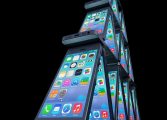Apple USB-C: A Comprehensive Overview

Introduction
In the world of modern technology, USB-C has become a dominant connector for various devices, including Apple’s products. With its widespread adoption, understanding the nuances of ”Apple USB-C” is crucial for tech enthusiasts and everyday consumers alike. This article aims to provide an in-depth exploration of Apple’s USB-C, covering its characteristics, variations, popularity, quantitative measurements, differences between models, and a historical analysis of its advantages and disadvantages.
1. An Overview of Apple USB-C

Apple USB-C is a type of universal connector developed by Apple Inc. It offers a compact, reversible design, enabling both data transfer and power delivery for devices such as laptops, smartphones, tablets, and even peripherals. Unlike its predecessor, the USB-A, Apple USB-C features a symmetrical design that eliminates the need for flipping the connector to connect it correctly.
2. Presentation of Apple USB-C Types and Popularity
Apple USB-C comes in various types, catering to different needs and device compatibility. The primary Apple USB-C cables and adapters include:
a) USB-C to Lightning Cable: This cable allows for fast charging and data syncing between Apple devices, such as iPhones and iPads. It has gained popularity due to its compatibility with the latest generation iPhones and iPads.
b) USB-C to USB-C Cable: This cable is widely used for connecting Apple devices, such as MacBook Pro or MacBook Air, to various peripherals, external displays, and power adapters. The USB-C to USB-C cable enables high-speed data transfer and power delivery.
c) USB-C Power Adapter: Apple offers USB-C power adapters of different wattages, allowing users to charge their devices efficiently. This adapter is often sold separately and can be used with both USB-C to Lightning and USB-C to USB-C cables.
3. Quantitative Measurements of Apple USB-C
When it comes to quantitative measurements of Apple USB-C, several factors are worth considering:
a) Data Transfer Speed: Apple USB-C supports high data transfer rates, with theoretical speeds reaching up to 10 Gigabits per second (Gbps) for USB 3.1 Gen 2. This allows for quick file transfers, backups, and seamless connectivity.
b) Power Delivery: Apple USB-C’s Power Delivery (PD) technology provides versatile charging options. It offers up to 100W power delivery, allowing users to charge not only iPhones and iPads but also laptops and other power-hungry devices using a single USB-C cable.
4. Discussion on Differentiating Apple USB-C Models
Despite the universal nature of USB-C, it is important to understand that different Apple USB-C models may exhibit variations in their capabilities. These differences can include power delivery capabilities, data transfer speeds, and compatibility with Apple devices. Therefore, it is crucial to select the correct USB-C model based on individual requirements and device compatibility.
5. Historical Analysis of Advantages and Disadvantages of Apple USB-C
Over the years, Apple’s USB-C has shown several advantages, such as:
a) Versatility: Apple USB-C’s ability to transfer both data and power makes it a versatile connector for various devices, eliminating the need for multiple cables.
b) Reversible Design: Unlike its predecessor, the USB-A, Apple USB-C’s reversible design allows for effortless connections, reducing frustration for users.
However, some disadvantages have also been associated with Apple USB-C:
a) Compatibility: While USB-C is gaining popularity, there are still many devices and peripherals that require adapters or converters to connect with Apple USB-C devices.
b) Cost: USB-C adapters and cables, especially those specifically designed for Apple products, can be more expensive compared to their USB-A counterparts.
Conclusion
In conclusion, Apple USB-C offers a significant advancement in connecting devices, providing versatility, high-speed data transfer, and power delivery capabilities. Understanding the types, popularity, quantitative measurements, differences between models, and historical advantages and disadvantages of Apple USB-C is essential for consumers navigating the ever-evolving landscape of technology. By choosing the right USB-C variant for their needs, users can fully leverage the benefits of Apple’s USB-C ecosystem.
*Note: The placement of the video clip will depend on the specific content or topic related to ”Apple USB-C.”
















































